When it comes to foldable phones, Samsung has hit the ball out of the park with its latest flagship foldable models: The Galaxy Z Fold 4 and the Galaxy Z Flip 4. It’s fair to say reviews so far have judged these folding phones to be home runs. No, they’re still not perfect — not yet — but Samsung’s most recent try makes it clear that folding smartphones will be a valid design alternative to the “Great Glass Slab” from now on.
For the moment, folding phones come at a premium. Despite their hefty price tags, the marketplace for foldables continues to heat up. Apple analyst Ming-Chi Kuo has predicted foldable smartphones will eventually become a “must-have” offering for major smartphone brands. The compact, hybrid folding phone-slash-tablet combo is designed for people who seek more screen real estate but dislike the newer gigantic phablets. The small models are for those who always longed for their clamshells of old.
In addition to Samsung’s latest handsets, the few foldable phones available sport a variety of styles and forms, while TCL has famously experimented with less conventional design concepts.
In the future, we expect folding phones from companies such as TCL and Apple, though some manufacturers may target local markets, like the Vivo X Fold, the Oppo Find N, the Xiaomi Mi Mix Fold, and Mix Fold 2 — which landed a day after Samsung’s Galaxy Z Fold 4 — all currently only available in China. There’s even word of a foldable from Google, which could be the Pixel Fold or Pixel Notepad.
As companies like Samsung, Motorola, and Huawei lead the charge for a creative overhaul of the smartphone genre, we present the best foldable phones available today.
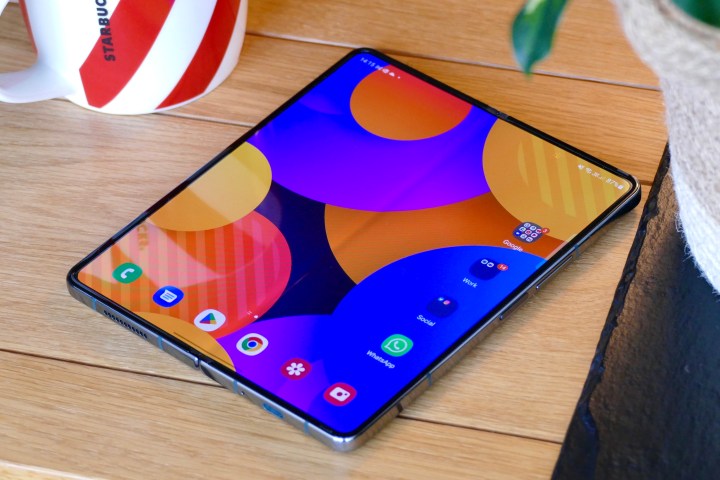
Andy Boxall/Digital Trends
Samsung Galaxy Z Fold 4
Pros
- Usable cover screen
- Excellent multitasking features
- Inner screen is great for games and video
- Reliable and fun camera
- Water resistant and durable materials
Cons
- Heavy use kills the battery
- Slow charging
The fourth generation of Samsung’s flagship foldable is here, and it’s everything we hoped for and more.
Available in Phantom Black, beige, Greygreen, or a Samsung-exclusive burgundy, the Z Fold 4 boasts a 6.2-inch Dynamic AMOLED 120Hz cover screen and a 7.6-inch Dynamic AMOLED 120Hz main screen. There’s the same under-display camera hidden beneath the main screen.
This is a heavy, chunky phone, weighing in at 263 grams and measuring 15.8mm thick — but it’s not as hefty as the Z Fold 3. There’s also a new hinge design that makes for more effective one-handed use, and you’ll notice the Z Fold 4 isn’t quite as tall nor as slim as its predecessor. It almost feels like holding a non-folding phone.
Multitasking is where this foldable shines, though, with Android 12L letting you split the screen into four apps at once, and the new Taskbar allows for adding icons to the bottom of the screen just like Windows Taskbar or Mac OS’s Dock. Under the hood, there’s the latest Snapdragon 8+ Gen 1 processor, with 12GB of RAM and up to 1TB of storage.
The Z Fold 4 sports 50MP main, 12MP wide-angle, and 10MP telephoto with 3 x optical zoom and 30x max digital zoom lenses, plus shoots 8K video at 24fps.
If there’s one thing that lets down this productivity powerhouse, it’s the slightly weak 4,400mAh battery and slow 25W wired charging speeds. But if you’re a serious multitasker looking for a stunning, powerful phone with better battery life than the Z Flip 4, this is the foldable to get.
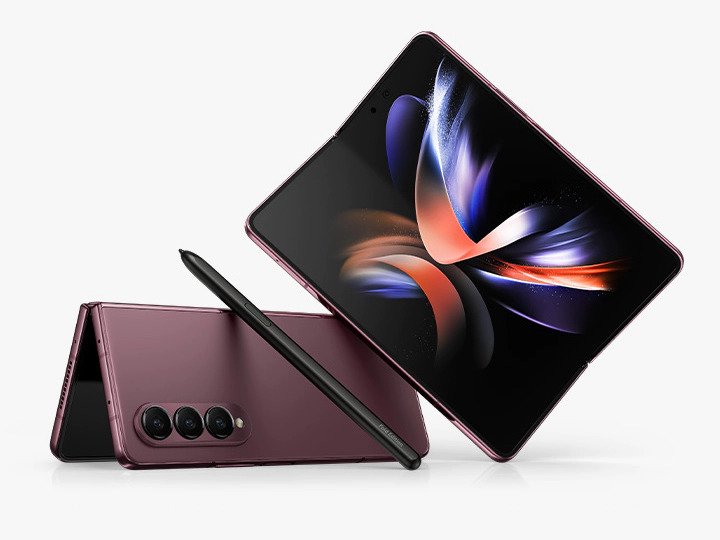

Joe Maring/Digital Trends
Samsung Galaxy Z Flip 4
Pros
- Flatter design looks and feels fantastic
- Bespoke customization is unmatched
- Excellent main display
- Blazing fast performance
- Good, fun cameras
Cons
- Battery still only lasts a day
- Limited cover screen functionality
The Z Flip 4 takes everything we loved about the Z Flip 3 and adds some key iterative improvements. In our review, we go so far as to say this is an (almost) perfect foldable flip phone, and it’s easy to see why.
The Galaxy Z Flip 4 boasts the same cute clamshell design as its predecessor, but this time around there’s a flatter frame with a slightly smaller hinge, giving the phone a more compact, pocket-friendly footprint. The frosted matte glass panel on the rear hides fingerprints and feels luxe, while the slimmer hinge should still survive over 200,000 folds, according to Samsung. The Z Flip 4 comes in Bora Purple, Blue, Pink Gold, Graphite, or a range of Bespoke Studio colors.
With its 6.7-inch Dynamic AMOLED 2x display with 120Hz variable refresh rate and 1.9-inch Super AMOLED cover screen, things don’t look that different from the Z Flip 3, but this time around you get Qualcomm’s latest Snapdragon 8+ Gen 1 chip with 8GB of RAM, and a beefier 3,700mAh battery with faster 25W wired charging.
Samsung’s also packed 12MP primary, 12MP ultrawide, and 10MP selfie cameras on board the Z Flip 4, with a 65% brighter sensor that should mean better lowlight photography.
The Z Flip 3 was a bestseller for Samsung, and with these small but important upgrades, the Z Flip 4 looks set to follow hot on its heels. However, despite better battery life, you’re only going to get a full day out of this phone, and the 8GB of RAM may be limiting if you’re a serious multitasker, in which case the Z Fold 4 is likely a better choice for you.


Motorola Razr (2020)
Pros
- Water-repellent design
- Smaller chin than 2019 Razr
- Improved hinge
Cons
- No microSD card slot
- Small 2,800mAh battery
This latest model is Motorola’s successor to the Razr 2019 and addresses many of the complaints about the older phone, including a lack of splash resistance. The Razr 2020, available unlocked, heavily resembles the look of the older model, with the same size, clamshell design, and dimensions, as well as the internal 6.2-inch 21:9 foldable display and external 2.7-inch Quick View display. It also runs the same software — though the Quick View display can now run any app, accomplish quick tasks, and reply to messages. The new device sports 3D curved glass on both sides with an aluminum frame in Black, Blush Gold, and Gray. The chin at the bottom is smoother and smaller, and the fingerprint sensor is now on the back of the phone.
You might want to hold off and see if the new Motorola Razr 2022 comes to the U.S. and other markets, though. It launched in August 2022 in China, but there’s no word of a wider release yet.

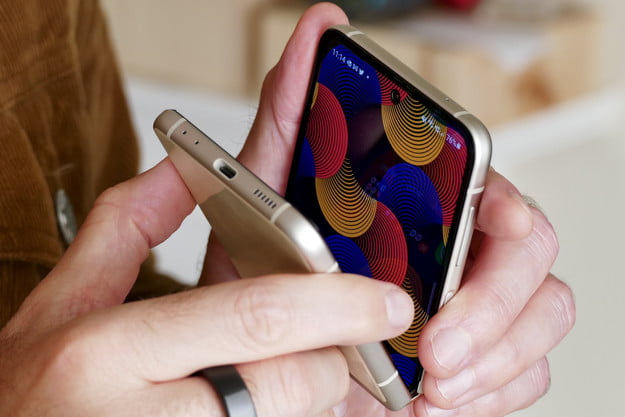
Andy Boxall/Digital Trends
Samsung Galaxy Z Flip 3
Pros
- Truly compact
- Water resistance increases durability
- Beautiful screen
- Cutting-edge, eye-catching design
Cons
- One-day battery life
- Cover Screen lacks features
Though it’s last year’s model, the 4.2-inch Samsung Galaxy Z Flip 3 — in Cream, Green, Lavender, or Phantom Black, plus a range of Bespoke Edition colors — is still a bestseller for a reason. You’re still getting a 6.7-inch dynamic AMOLED 2x, 120Hz display with a 1.9-inch cover screen, an IPX8 water resistance rating, and a dual rear camera.
True, you’re not getting Qualcomm’s latest chip, but the Snapdragon 888 5G paired with 8GB of RAM and up to 256GB of onboard storage packs plenty of processing power. The only real reason to upgrade to the Z Flip 4 instead is that the Z Flip 3’s tiny 3,300mAh battery is unlikely to see you through a full day of heavy usage, and with 15W wired charging, it’s not the fastest getting back up and running, either.
That said, the Galaxy Z Flip 3 is still an excellent introduction to the world of foldables and will save you $100 to boot. You can pick up the 128GB version from Samsung starting from $900.

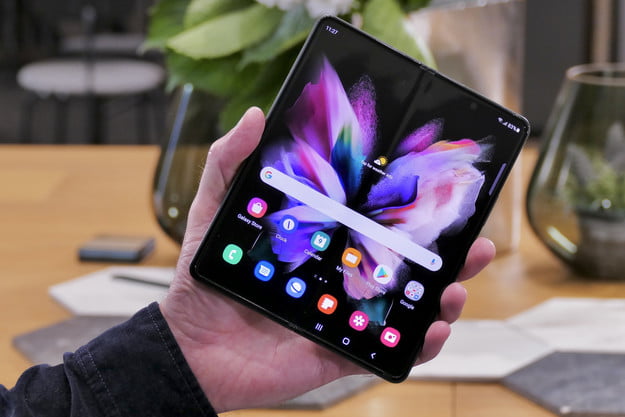
Andy Boxall/Digital Trends
Samsung Galaxy Z Fold 3
Pros
- Improved screen durability and IPX8 waterproofing
- Powerful hardware and capabilities
- Solid rear cameras
- Great for multitasking and productivity
Cons
- Still expensive
- Lackluster battery life
Last year’s Galaxy Z Fold 3 was a revelation: a foldable powerhouse of productivity with an expansive folding screen, marvelous multitasking capabilities, S Pen support, and IPX8 rating water resistance.
Despite the release of the Z Fold 4, the Z Fold 3 remains an excellent buy. Side by side with the newest generation of the Z Fold, the two phones seem practically identical, and the specs haven’t changed much either. You’re still getting a 7.6-inch AMOLED 2x main screen, with a 6.2-inch cover display. There’s an under-display camera hidden beneath the main screen, 120Hz refresh rate across both displays, and stereo speakers.
One of the main differences between the two phones is the camera: Here you’re getting a 12MP telephoto, 12MP wide-angle, and 12MP ultra-wide cameras packed into an Armor Aluminum frame, missing out on the 50MP main the Z Fold 4 offers.
Under the hood there’s the snappy Snapdragon 888 with 12GB of RAM, capable of handling everything including the latest games, but only up to 512GB of storage. Most people will never need the 1TB of storage offered by the Z Fold 4, but it’s definitely something to consider, as there’s no expandable storage on offer here. There’s also the same 4,400mAh battery and 25W wired charging. Plus all the same productivity features are on offer, with S Pen support, though the Z Fold 3 runs Android 12 and doesn’t benefit from the features Android 12L brings to the Z Fold 4 (like the new taskbar).
The final deciding factor here may be the phone’s size and weight. The Z Fold 3 feels less comfortable and heftier for one-handed use than Samsung’s latest Z Fold 4, which boasts a shorter, broader profile and refined hinge. So if you use your phone one-handed or have smaller hands, the newer Z Fold 4 might be a better choice.
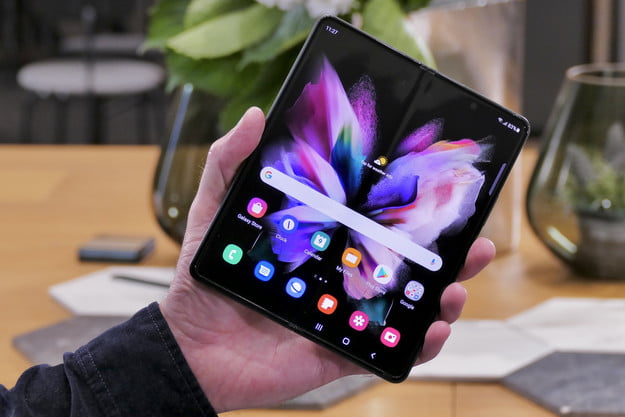
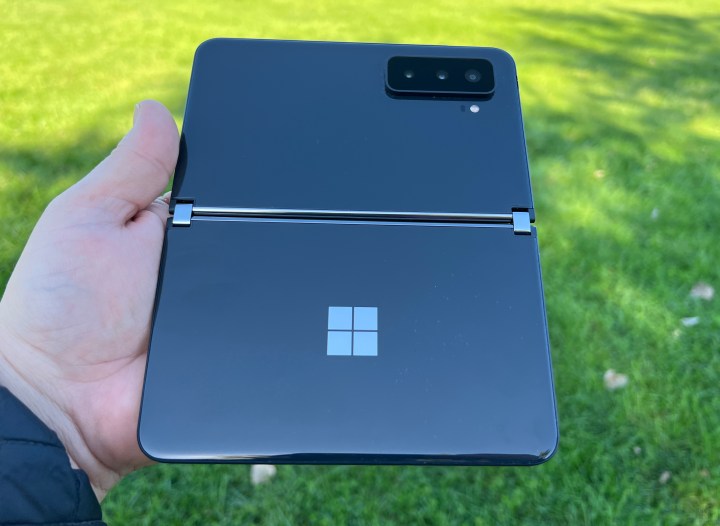
Adam Doud/Digital Trends
Microsoft Surface Duo 2
Pros
- Marked camera upgrade over predecessor
- Large aspect ratio for reading and multitasking
- Software is largely fixed
- Top-tier flagship specifications
- Superior multitasking capabilities
Cons
- Poor lowlight camera performance
- Awkward to hold for camera use
- Still a few software bugs to work out
In October 2021, Microsoft released the Surface Duo 2, the follow-up to the original Surface Duo. This dual-screen phone ships with Android 11 and, when unfolded, has a larger 8.3-inch display than its predecessor, measuring in at 5.8 inches while folded. The PixelSense AMOLED display has a resolution of 2688 x 1892 while open and 1344 x 1892 when closed. There’s also a bump to a 90Hz refresh rate. The phone can fold completely closed, open like a book, or fold back on itself for single-screen use.
Under the hood, the Surface Duo 2 packs a Snapdragon 888 processor, 8GB of RAM, and up to 512GB of onboard storage. Strong battery life and a triple camera array round out the package, plus 5G for future-proofing and NFC. However, unlike Samsung’s foldables there’s no IP rating here.

Frequently Asked Questions
What sets a foldable phone apart from a normal phone?
There are two major genres of foldable phones: A tablet that folds in half and a clamshell that’s reminiscent of the folding cell phones of the early 2000s. Both designs are compelling.
With a large foldable phone like the Galaxy Z Fold 4, you get a generous screen for videos, games, reading, and web browsing. Splitting the screen into multiple sections lets you display different content while using apps, watching videos, messaging, or zipping through your Google photos. The Galaxy Z Flip 4, for example, offers unique features, and can also work as a tripod while taking pictures with the front or back cameras.
Whether you choose a large or small model, a foldable phone boosts the value of your device. Large screen devices fold out to tablet size while a smaller size clamshell fits easily into your pocket. Samsung’s App Continuity feature gives folding phones the flexibility to adapt apps for more than one screen on the fly.
Who should consider a foldable phone?
A big-screen folding phone does things flat phones can’t. It lets you play games, read PDFs, and create content in unique ways — all at the same time. Even more than the largest slab phone, it can serve as your exclusive device for most of the day, allowing you to multitask on split windows and screens. If you need your phone for multitasking, movie watching, viewing maps, and using productivity or art apps, a folding phone may be in your future.
Which type of foldable phone should I pick?
When deciding which foldable phone you want, first decide what functions are most important to you. Are you looking for productivity? Or are you looking for the most convenient small device that fits in your pants pocket? Sometimes it’s not an either/or question. If you want to use your mobile device for reading, either size makes a great reader, but for larger format documents, a fold-out phone makes more sense. While it may seem like a larger screen is best for video watching, a clamshell is both lighter and more widescreen compatible. Depending on your favorite games, you may pick the size based on your gameplay preferences.
What can you expect to pay for a quality foldable phone?
Foldable phones are very expensive right now because they are made with new technology and processes that are still being perfected with materials still being sourced. You should expect to pay at least $1,000 for a high-quality foldable phone, which is the price of the Samsung Z Flip 4. The clamshell style is pocketable, but with nicely updated screen technology and a bigger battery than its predecessor. For an even larger phone, like the Galaxy Z Fold 4, you can expect to pay at least $1,800 to over $2,000. However, you may get a bargain if you can trade in an older phone or get in on the ground floor of sales offerings.
Editors’ Recommendations




